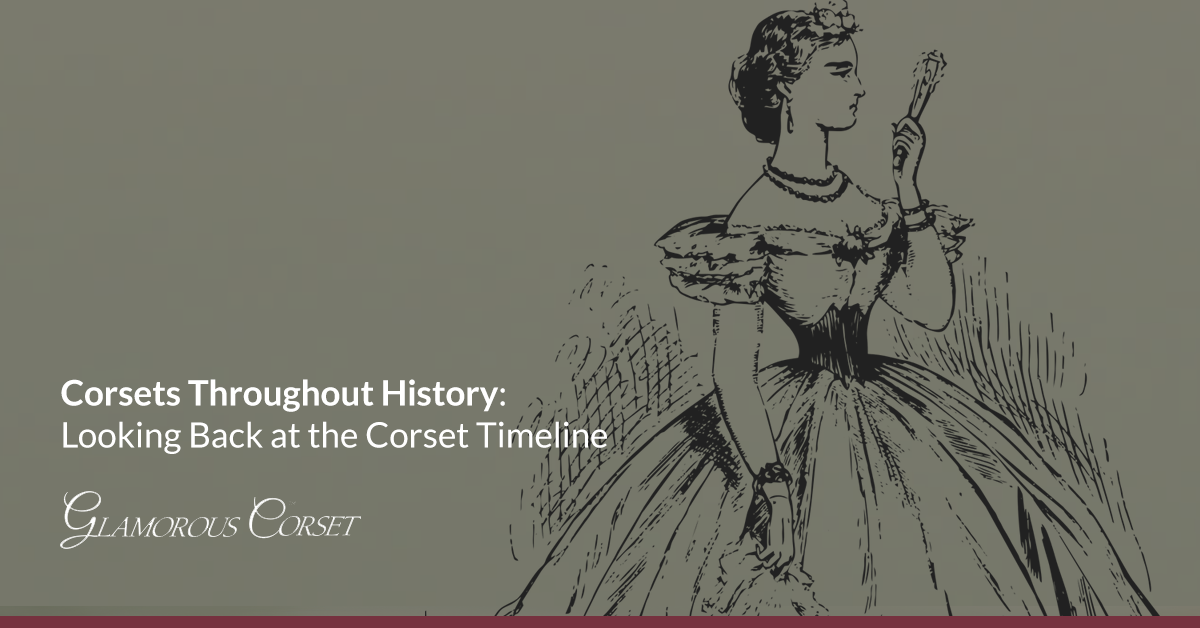Blog
Corsets Throughout History: Looking Back at the Corset Timeline
Although most of us have seen enough to know that corsets were popular in both the Elizabethan and Victorian eras, you might not know that the use of this cinching garment dates back much further, as evidenced by historical records. It’s amazing to think that clothing styles worn thousands of years ago are still in use today, but when you consider that Indian sarees were first worn 5,000 years ago and togas popular in Rome 2,500 years ago are mirrored in the modern kaftan (just check out Maya Rudolphs’s slouchy 2020 Academy Awards gown), it’s not a stretch to see how a support garment as useful as the corset has been around for so long.
The history of corsets is a long one, in which many changes in style, construction, and materials have taken place. The corsets of old are recognizable, but they were very different from the modern support garments we enjoy today. Here’s a look back at corsets throughout history and how they’ve evolved.
The Earliest Corsets
Art often provides an indication of fashion trends from different eras, as delicate textiles and garments are so easily lost to the ravages of time. In the case of corsetry, a figurine of a Minoan snake goddess dating back to roughly 1600 BC Crete offers a clue into just how early corsets may have been worn. This small figure, akin to those found in house sanctuaries, is depicted in a tiered skirt and a corset-like garment around the waist and underbust area. In truth, images from pottery depict both men and women of the civilization wearing this corset-like clothing.
The Renaissance and Beyond
While corsetry didn’t really take off in a big way until the 16th century, 15th century France saw a rise in popularity of a garment known as a “cotte”, a version of the looser tunics or gowns from the middle ages that featured an open neckline. The 15th century version was tightened around the torso with the use of lacing in the front or back. It was typically paired with other garments, such as a surcotte (or surcote) featuring open sleeves or even side cutouts to show the fitted garment beneath.
As the 16th century dawned, women’s fashion became even more daring, with well-known figures like Catherine de Medici popularized cinched, elongated corsets that formed a sort of inverted cone descending to the hips. The shape of these corsets was meant to emphasize the smallness of the waist, especially when paired with farthingales (essentially hoop skirts) designed to cause the skirt to flare out dramatically.
Corsets of this era were meant to flatten the stomach and bust with front panels featuring a wood or bone rod, then called a busk, and significant tightlacing designed to produce a stiff appearance popular among the aristocracy. It also became fashionable during this time to wear a V-shaped decorative panel known as a “stomacher” over the front of the corset to conceal lacing. One of the most recognizable examples of this style is seen in the elaborate garments worn by Queen Elizabeth of England.
The Age of Enlightenment
The shape of the corset didn’t change significantly during the 1700s, but the purpose shifted slightly. During this time, inverted cone corsets, also referred to as stays, were designed to create an even more exaggerated hourglass figure, constricting and slimming the lower torso all around, pushing up the bust, and pulling the shoulders together to exaggerate posture and thrust the bosom forward. This required the use of stiff fabrics and boning.
During this time, jumps also appeared and gained popularity, perhaps because some women wished to remain fashionable, but avoid the constriction of stays. Jumps were short, sleeveless jackets made of softer materials (linen, cotton, silk, etc.) that offered support through padding and partial boning. Even women who wore stiff corsets might turn to more comfortable jumps for informal wear.
Victorian Corsetry
While the early 1800s saw corsets become much shorter with the popularity of the empire waist style in women’s dresses, the styles of the Victorian era returned to longer corsetry designed to emphasize a more natural hourglass figure, insomuch as they nipped in at the waist and flared out over the hips and at the bust (rather than pulling the shoulder blades together to push the bust up and out). These corsets were designed to cinch in more at the natural waist, rather than constricting the entire torso.
Tightlacing gained popularity in this era as women tried to achieved tiny waistlines. One of the greatest innovations of this era was the addition of modern busks that allowed women greater ability to get into and out of corsets on their own. Also notable was the introduction of steel boning, although baleen was still used extensively.
Corsets in the Modern Era
The 20th century saw corsets go out of fashion with women’s suffrage, the growth of looser clothing styles, and the introduction of modern undergarments like brassieres, girdles, and eventually, Spanx. Today, women wear corsets by choice, not because they’re expected to, and use them to flatter the figure, slim the waist, and boost confidence. Although corsets throughout history have been used largely for fashion, modern women rely on these supportive garments for all kinds of personal reasons, and often find a form of liberation in wearing them.
Stay up-to-date with weekly blog posts, waist training tips, and the chance to win one of our monthly corset giveaways, like us on Facebook & subscribe to our mailing list today! Want to find the perfect steel boned corset? Shop some of our favorites: underbust corsets, overbust corsets, corset dresses. You can also shop our corsets by material: cotton corsets, denim corsets, leather corsets, mesh corsets, pvc corsets, and satin corsets.

My name is Rachel, I am the owner of Glamorous Corset, a small business founded by me in 2010. Back In 2005, I was in a car accident that left me with a herniated disk. Much to my surprise I learned steel boned corsets were beneficial to several medical injuries including mine. I was always intrigued with corsetry, their history and their beautiful aesthetic. I love sharing knowledge about corsets, educating my wonderful readers and breaking the negative stigma related to corsetry. In combination with my years of research and personal experience I hope my articles are useful and can help anyone who has struggled with some of the same things I have. More about me…


